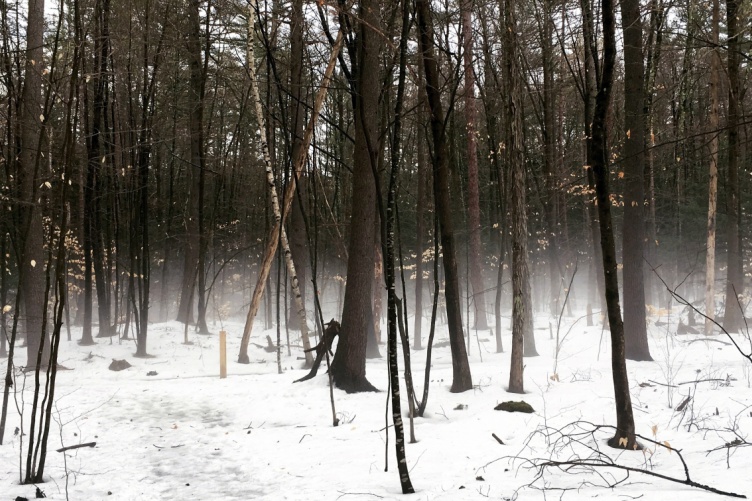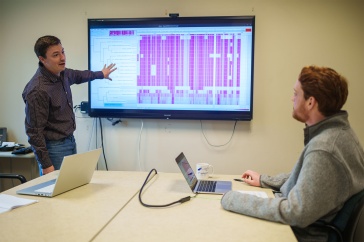
Fog over melting snowpack in forest understory at Thompson Farm forest. Credit: Rebecca Sanders-DeMott/UNH
New England’s warmer, snow-free winters may increase carbon dioxide losses in forests, where deciduous trees can’t take advantage of warm temperatures before their leaves emerge. However, farms cultivating grasses have a greater potential to start growing in the winter “dormant season,” perhaps partially offsetting the increasing winter carbon losses from forests, according to new research from the New Hampshire Agricultural Experiment Station at the University of New Hampshire.
“New England’s winters are becoming increasingly variable, but the effects on different ecosystems, such as forests and farms, are poorly understood. We are trying to determine how changing winter conditions will affect how plants and soils in these ecosystems process carbon. The flow of carbon provides a unique picture of the health and function of ecosystems: uptake of carbon dioxide occurs when plants photosynthesize and grow, while carbon dioxide losses are a result of respiration by both plants and the microscopic organisms that live in soils,” said Dr. Rebecca Sanders-DeMott, postdoctoral research associate supported by the experiment station.

“Forests and agricultural lands both provide critical services for the people of New Hampshire and New England, such as energy, food, and support for tourism and lifestyle. Each land cover type also has distinct influence on environmental quality, such as storing or releasing different quantities of greenhouse gases, like carbon dioxide, that influence global climate. For example, forests in New England are a much stronger sink for carbon than agricultural lands when we consider the whole annual cycle. But, as climate changes in our region, it is important to understand how the reliability of how these economic and environmental services may change,” Sanders-DeMott said.
To evaluate the impact of warmer, more variable winters on New England ecosystems, Sanders-DeMott and her collaborators have been using sophisticated instrumentation since 2014 at the experiment station’s Thompson Farm forest in Durham and Kingman Research Farm hayfield in Madbury to continuously monitor how much carbon dioxide is moving into and out of the ecosystem.
Automated sensors mounted on towers above the vegetation canopy measure wind speed, air temperature, and carbon dioxide concentrations ten times every second. By examining the uptake and loss of carbon at each site across several winters with variable weather conditions, scientists are learning about how winter climate affects ecosystems that are important components of the New England landscape.
In addition, Emily Wilcox, an undergraduate in earth sciences, Dr. Elizabeth Burakowski, research assistant professor in earth sciences, Dr. Alexandra Contosta, research assistant professor in environmental science and soil science, and Sanders-DeMott have been making daily measurements of snow and soil frost depth at both Thompson Farm forest and Kingman Farm hayfield beginning in December 2017. These data will help researchers understand how the effect of snow on soil temperatures and frost depth affects the patterns of carbon dioxide uptake and loss from forests and grasslands.
“We have experienced a lot of variation in winter weather in just the last few years. While winter 2014-2015 was quite cold and snowy, winter 2016-2017 was on the warmer side of what we consider normal, and in the winter 2015-2016 we saw the warmest air temperatures ever recorded in New England. Conditions in winter 2015-2016 were so warm that the grasses at the Kingman Research Farm began growing in February and kept growing into the summer. This early growth resulted in the grassland becoming a sink for carbon dioxide -- taking up and storing more carbon dioxide than it released -- in February to April of 2016, whereas in a typical year the grassland would be a carbon dioxide source during this period,” Sanders-DeMott said.

In contrast to the Kingman Research Farm grasses, she said the Thompson Farm forest showed a more sluggish response to the warm 2015-2016 winter. Although the evergreen pine trees started to grow earlier than normal in mid-March 2016, the deciduous maples and oaks hadn’t yet produced new leaves and couldn’t capitalize on the warm weather. Instead, the warm temperatures and lack of snow caused unusually high levels of respiration in soils and a very large loss of carbon to the atmosphere from February to April 2016. Although the forest usually loses carbon dioxide to the atmosphere during this time of year, in 2016 the amount of carbon dioxide lost was three times greater than a typical year.
“Changes in winter climate, such as warmer air temperatures and less snow cover, can influence plant and soils in the following growing season,” Sanders-DeMott said. “A better understanding of how winter weather affects ecosystems will help us predict whether our ecosystems will exacerbate or mitigate climate change by taking up or removing carbon dioxide from the atmosphere.”
This research was presented recently at the American Geophysical Union Annual Meeting in New Orleans, LA, and at the 11th Annual Lamprey River Research Symposium at UNH. UNH research collaborators also include experiment station researcher Dr. Scott Ollinger, professor of ecosystem ecology and remote sensing; Dr. Andrew Ouimette, research scientist in ecosystem ecology; and Sean Fogarty, field research assistant.
This material is based upon work supported by the NH Agricultural Experiment Station, through joint funding of the National Institute of Food and Agriculture, U.S. Department of Agriculture, under award number 1006997, and the state of New Hampshire. Sanders-DeMott also is supported by an experiment station Postdoctoral Scientists Support Program Award. Additional funding for this project comes from NH EPSCoR/NSF Research Infrastructure Improvement Award EPS 1101245 and NASA Carbon Cycle Science NNX14AJ18G.
Founded in 1887, the NH Agricultural Experiment Station at the UNH College of Life Sciences and Agriculture is UNH’s original research center and an elemental component of New Hampshire's land-grant university heritage and mission. We steward federal and state funding, including support from the USDA National Institute of Food and Agriculture, to provide unbiased and objective research concerning diverse aspects of sustainable agriculture and foods, aquaculture, forest management, and related wildlife, natural resources and rural community topics. We maintain the Woodman and Kingman agronomy and horticultural research farms, the Macfarlane Research Greenhouses, the Fairchild Dairy Teaching and Research Center, and the Organic Dairy Research Farm. Additional properties also provide forage, forests and woodlands in direct support to research, teaching, and outreach.
-
Written By:
Lori Tyler Gula, PhD | NH Agricultural Experiment Station | lori.gula@unh.edu | 603-862-1452

















































